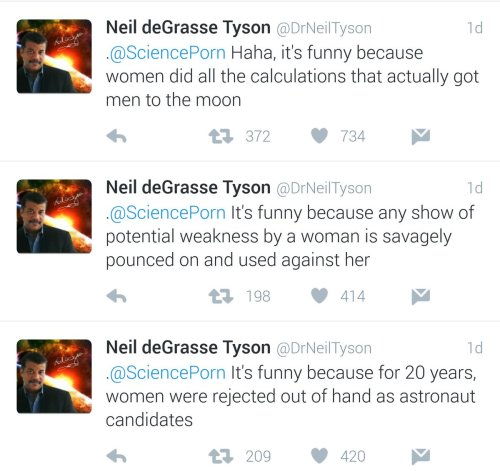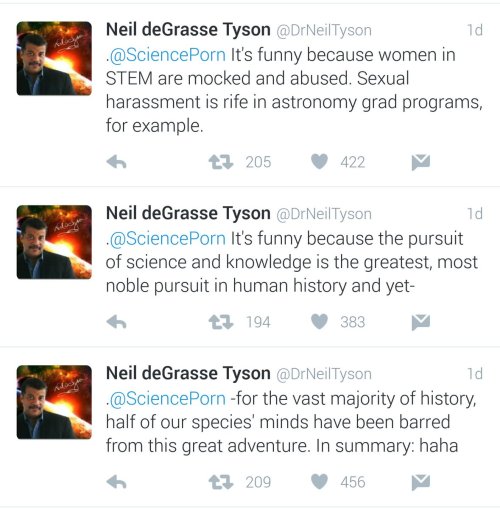Scistrike-blog - Science Denier Hall Of Shame




More Posts from Scistrike-blog and Others
Eric Hovind 5, Episode I
Eric Hovind is at it again. Following in his father Kent Hovind’s footsteps, he happily dismisses the theory of evolution, the Big Bang theory, the geologic column and just about everything else modern science has discovered. The alternative he (and Kent) offer? ‘GODDIDIT! In this episode, Eric uses one of his dad’s best tricks;…
View On WordPress
#NASASocial
Solar System: OSIRIS-REx and Bennu
Let us lead you on a journey of our solar system. Here are some things to know this week.
This week, we’re setting out on an ambitious quest: our first mission to retrieve a sample from an asteroid and return it to the Earth.
1. Take It from the Beginning

Some asteroids are time capsules from the very beginnings of our solar system. Some meteorites that fall to Earth originate from asteroids. Laboratory tests of materials found in meteorites date to before the sun started shining. OSIRIS-REx’s destination, the near-Earth asteroid Bennu, intrigues scientists in part because it is thought to be composed of the primitive building blocks of the solar system.
Meet asteroid Bennu
Take a tour of asteroids in our solar system.
2. Creating the Right Ship for the Journey

At the heart of the OSIRIS-REx mission is the robotic spacecraft that will fly to Bennu, acting as the surrogate eyes and hands of researchers on Earth. With its solar panels deployed, the craft is about 20 feet (6 meters) long and 10 feet (3 meters) high. Packed into that space are the sample retrieval system, the capsule for returning the sample to the ground on Earth, plus all the hardware for navigation and communicating with home.
Explore the instruments and how they work
3. School of Hard Rocks

If you’re a teacher or a student, the OSIRIS-REx mission and exploring asteroids make for some engaging lesson material. Here are some of the things you can try.
Find dozens of lesson plans
4. Standing (or Flying) on the Shoulders of Giants

OSIRIS-REx is not the first time we have explored an asteroid. Several robotic spacecraft led the way, such as the NEAR Shoemaker probe that orbited, and even landed on, the asteroid Eros.
Meet the asteroid pioneers and see what they discovered
5. The Probability of Successfully Navigating an Asteroid Field is…Pretty High

How much of what we see in movies about asteroids is fact, and how much is fiction? This video lays out the basics. (Spoiler alert: even though there are millions of them, the average distance between asteroids in the main belt is something like 1.8 million miles, or about three million kilometers.)
+ Watch + See more videos that explain asteroids and the mission
Discover the full list of 10 things to know about our solar system this week HERE.
Make sure to follow us on Tumblr for your regular dose of space: http://nasa.tumblr.com
Science Denier Hall of Shame Rep to Attend Launch
FOR IMMEDIATE RELEASE A representative of Science Denier Hall of Shame/Science Strike Force will be attending a NASA Social event for the launch of Orbital ATK Antares Rocket at NASA’s Wallops Flight Facility in Virginia.
“NASA commercial cargo provider Orbital ATK is scheduled to launch its sixth mission to the International Space Station at 9:13 p.m. EDT Thursday, Oct. 13.”
– NASA (More…
View On WordPress
Penn Jillette and Carolina Peña at Reason Rally
Penn Jillette and Carolina Peña at #ReasonRally
Saturday, June 4th, Penn Jillette introduced Carolina Peña, a former contestant on ‘Equador’s Got Talent’ on the main stage at Reason Rally in Washington DC. Carolina was berated by three of the four judges, not for her singing abilities or overall talent, but for lacking a belief in any gods. She was told that, basically, without God, she could have no talent. The fourth judge quite rightly…
View On WordPress
How Exactly Do We Plan to Bring an Asteroid Sample Back to Earth?
Our OSIRIS-REx spacecraft launches today, and will travel to a near-Earth asteroid, called Bennu. While there, it will collect a sample to bring back to Earth for study. But how exactly do we plan to get this spacecraft there and bring the sample back?

Here’s the plan:
After launch, OSIRIS-REx will orbit the sun for a year, then use Earth’s gravitational field to assist it on its way to Bennu. In August 2018, the spacecraft’s approach to Bennu will begin.

The spacecraft will begin a detailed survey of Bennu two months after slowing to encounter the asteroid. The process will last over a year, and will include mapping of potential sample sites. After the selection of the final site, the spacecraft will briefly touch the surface of Bennu to retrieve a sample.

To collect a sample, the sampling arm will make contact with the surface of Bennu for about five seconds, during which it will release a burst of nitrogen gas. The procedure will cause rocks and surface material to be stirred up and captured in the sampler head. The spacecraft has enough nitrogen to allow three sampling attempts, to collect between 60 and 2000 grams (2-70 ounces).

In March 2021, the window for departure from the asteroid will open, and OSIRIS-REx will begin its return journey to Earth, arriving two and a half years later in September 2023.

The sample return capsule will separate from the spacecraft and enter the Earth’s atmosphere. The capsule containing the sample will be collected at the Utah Test and Training Range.

For two years after the sample return, the science team will catalog the sample and conduct analysis. We will also preserve at least 75% of the sample for further research by scientists worldwide, including future generations of scientists.
The Spacecraft

The OSIRIS-REx spacecraft is outfitted with some amazing instruments that will help complete the mission. Here’s a quick rundown:
The OCAMS Instrument Suite

PolyCam (center), MapCam (left) and SamCam (right) make up the camera suite on the spacecraft. These instruments are responsible for most of the visible light images that will be taken by the spacecraft.
OSIRIS-REx Laser Altimeter (OLA)

This instrument will provide a 3-D map of asteroid Bennu’s shape, which will allow scientists to understand the context of the asteroid’s geography and the sample location.
OSIRIS-REx Thermal Emission Spectrometer (OTES)

The OTES instrument will conduct surveys to map mineral and chemical abundances and will take the asteroid Bennu’s temperature.
OSIRIS-REx Visible and Infrared Spectrometer (OVIRS)

This instrument will measure visible and near infrared light from the asteroid. These observations could be used to identify water and organic materials.
Regolith X-Ray Imaging Spectrometer (REXIS)

REXIS can image X-ray emission from Bennu in order to provide an elemental abundance map of the asteroid’s surface.
Touch-and-Go Sample Arm Mechanism (TAGSAM)

This part of the spacecraft will be responsible for collecting a sample from Bennu’s surface.
Watch Launch and More!

OSIRIS-REx Talk Wednesday, Sept. 7 at noon EDT Join us for a discussion with representatives from the mission’s science and engineering teams. This talk will include an overview of the spacecraft and the science behind the mission. Social media followers can ask questions during this event by using #askNASA. Watch HERE.
Uncovering the Secrets of Asteroids Wednesday, Sept. 7 at 1 p.m. EDT During this panel, our scientists will discuss asteroids, how they relate to the origins of our solar system and the search for life beyond Earth. Social media followers can ask questions during this event by using #askNASA. Watch HERE.
LAUNCH COVERAGE!
Thursday, Sept. 8 starting at 4:30 p.m. EDT Watch the liftoff of the United Launch Alliance’s (ULA) Atlas V rocket from Kennedy Space Center in Florida at 7:05 p.m. Full coverage is available online starting at 4:30 p.m. Watch HERE. We will also stream the liftoff on Facebook Live starting at 6:45 p.m. EDT. Watch HERE.
Make sure to follow us on Tumblr for your regular dose of space: http://nasa.tumblr.com
Winner announced for the Golden Tinfoil Hat Award! The votes have been counted, and from the numerous worthy science-deniers and conspiracy theorists, one has risen to the top!

How to Avoid a Debate With a Flat-Earther: Simple. Just accept the flat-earther's challenge to a debate. https://plus.google.com/+SciStrike/posts/iBNQSUd3YML
Eric Hovind 5, Episode III: Flood Silliness and Age of the Earth
In this episode, Eric, once again, trips through a series of silly misrepresentations of observed reality.
He’s off to a great start when he complains that skeptics tend to say that the ‘Great Flood’ was a myth, and then immediately provides what he thinks is evidence to the contrary by mentioning that many cultures have flood…
View On WordPress
NASA test-fires booster for the Space Launch System (SLS) that will carry crew & cargo for the Mission to Mars! Take THAT, conspiracy theorists and flat-earthers!
-
 atsa-space-and-sici-fi reblogged this · 3 weeks ago
atsa-space-and-sici-fi reblogged this · 3 weeks ago -
 sou-sou-sou liked this · 2 months ago
sou-sou-sou liked this · 2 months ago -
 thesishome liked this · 3 months ago
thesishome liked this · 3 months ago -
 luna-di liked this · 3 months ago
luna-di liked this · 3 months ago -
 psycholyze liked this · 3 months ago
psycholyze liked this · 3 months ago -
 jo-phoenix liked this · 4 months ago
jo-phoenix liked this · 4 months ago -
 dani-65 liked this · 5 months ago
dani-65 liked this · 5 months ago -
 milopawpins liked this · 5 months ago
milopawpins liked this · 5 months ago -
 who-ever-said-i-was-nice liked this · 5 months ago
who-ever-said-i-was-nice liked this · 5 months ago -
 purplepri liked this · 5 months ago
purplepri liked this · 5 months ago -
 just-your-ordinary-captain liked this · 5 months ago
just-your-ordinary-captain liked this · 5 months ago -
 rowinablx reblogged this · 5 months ago
rowinablx reblogged this · 5 months ago -
 rowinablx liked this · 5 months ago
rowinablx liked this · 5 months ago -
 sunkissedv0dka-blog reblogged this · 5 months ago
sunkissedv0dka-blog reblogged this · 5 months ago -
 socialistwh0r3 liked this · 5 months ago
socialistwh0r3 liked this · 5 months ago -
 anna8xin1 liked this · 5 months ago
anna8xin1 liked this · 5 months ago -
 annaxpdoa liked this · 5 months ago
annaxpdoa liked this · 5 months ago -
 anna6bmeg liked this · 6 months ago
anna6bmeg liked this · 6 months ago -
 luna9876 liked this · 6 months ago
luna9876 liked this · 6 months ago -
 annarm02d liked this · 6 months ago
annarm02d liked this · 6 months ago -
 annaoayin liked this · 6 months ago
annaoayin liked this · 6 months ago -
 fablenaught reblogged this · 6 months ago
fablenaught reblogged this · 6 months ago -
 papayaslasher liked this · 7 months ago
papayaslasher liked this · 7 months ago -
 unknownerrorsstuff reblogged this · 7 months ago
unknownerrorsstuff reblogged this · 7 months ago -
 thatsmygirl6612 reblogged this · 7 months ago
thatsmygirl6612 reblogged this · 7 months ago -
 y2ksnowglobe reblogged this · 8 months ago
y2ksnowglobe reblogged this · 8 months ago -
 deviruo liked this · 8 months ago
deviruo liked this · 8 months ago -
 a-curly-haired-girl liked this · 8 months ago
a-curly-haired-girl liked this · 8 months ago -
 nyoooomofdoom liked this · 8 months ago
nyoooomofdoom liked this · 8 months ago -
 shipping-the-world liked this · 8 months ago
shipping-the-world liked this · 8 months ago -
 acefaun liked this · 9 months ago
acefaun liked this · 9 months ago -
 redcotai liked this · 9 months ago
redcotai liked this · 9 months ago -
 theteeniestleaf reblogged this · 9 months ago
theteeniestleaf reblogged this · 9 months ago -
 scourgewasright reblogged this · 9 months ago
scourgewasright reblogged this · 9 months ago -
 alatoartsalot liked this · 9 months ago
alatoartsalot liked this · 9 months ago -
 the-sand-guardian liked this · 9 months ago
the-sand-guardian liked this · 9 months ago -
 sabbyvii liked this · 9 months ago
sabbyvii liked this · 9 months ago -
 thefirewas-blue reblogged this · 9 months ago
thefirewas-blue reblogged this · 9 months ago -
 onlymahbones liked this · 9 months ago
onlymahbones liked this · 9 months ago -
 hopefulaceofspace liked this · 9 months ago
hopefulaceofspace liked this · 9 months ago -
 jas-lil-blog reblogged this · 9 months ago
jas-lil-blog reblogged this · 9 months ago -
 jas27 liked this · 9 months ago
jas27 liked this · 9 months ago -
 magicpony75 reblogged this · 9 months ago
magicpony75 reblogged this · 9 months ago -
 moondustpockets reblogged this · 9 months ago
moondustpockets reblogged this · 9 months ago -
 magicpony75 liked this · 9 months ago
magicpony75 liked this · 9 months ago -
 dangerouslyclassyhottub liked this · 9 months ago
dangerouslyclassyhottub liked this · 9 months ago -
 raimagnolia reblogged this · 9 months ago
raimagnolia reblogged this · 9 months ago -
 c45510p31a reblogged this · 9 months ago
c45510p31a reblogged this · 9 months ago -
 c45510p31a liked this · 9 months ago
c45510p31a liked this · 9 months ago
Exposing the misinformation of science-deniers, moon-hoaxers, flat-earthers and the rest of the tinfoil hat wearing crowd at www.sciencedenierhallofshame.com
99 posts